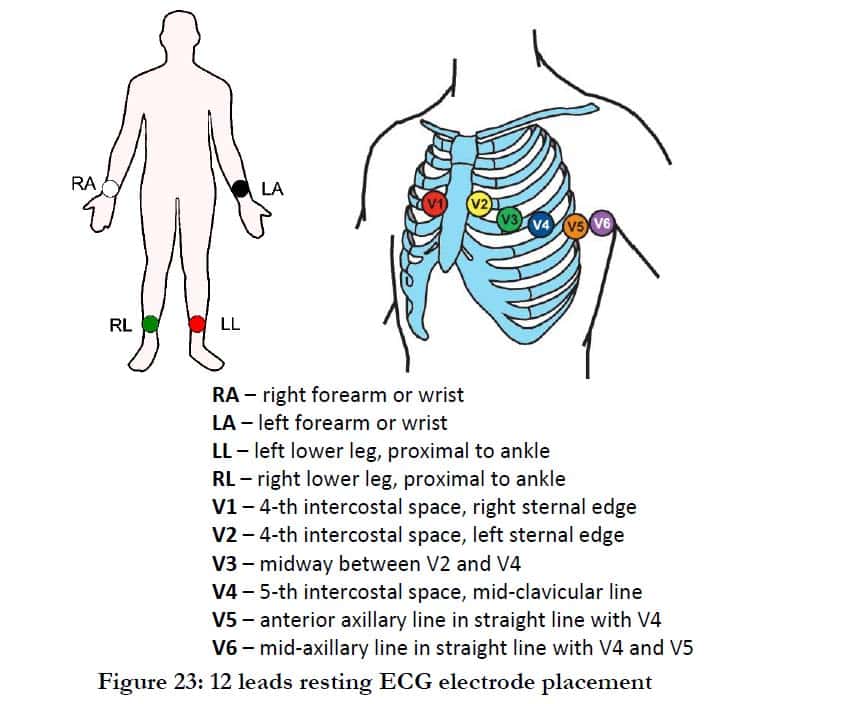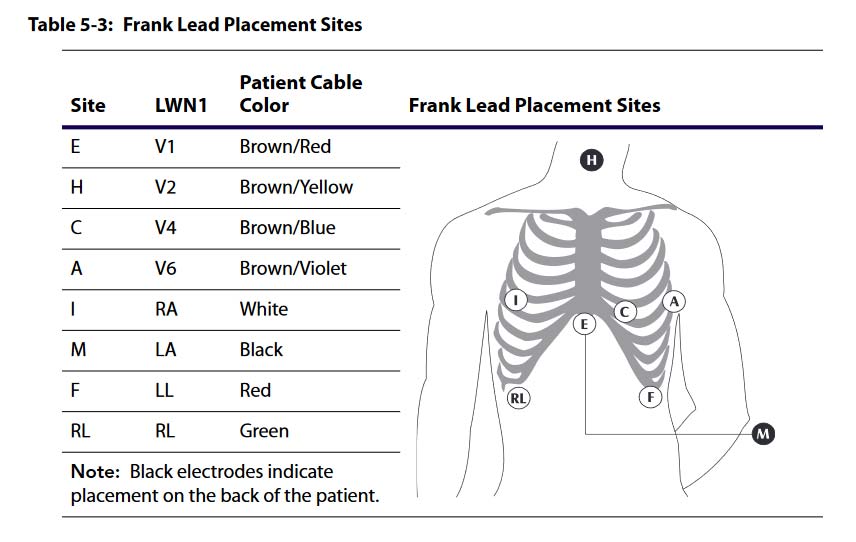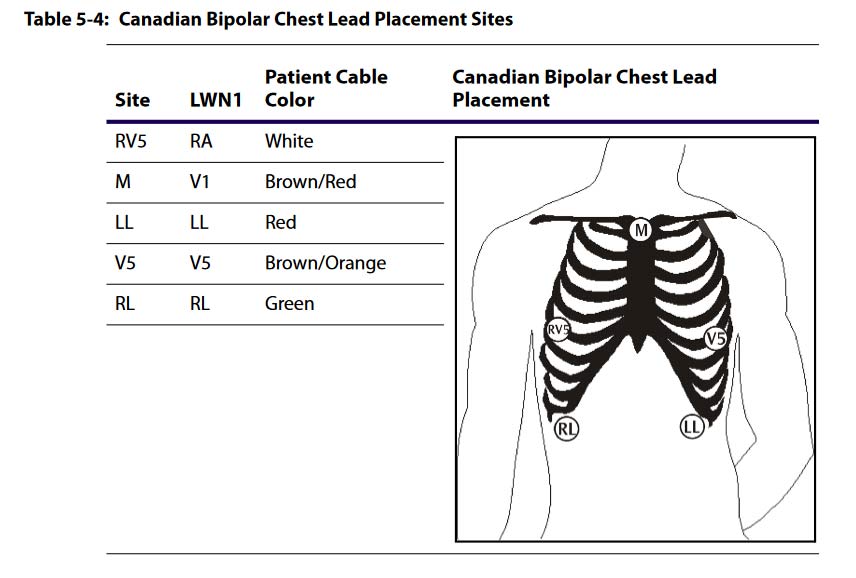12 Lead ECG Placement: A Step-by-Step Guide
The 12 lead ECG is a crucial diagnostic tool for assessing heart function. Proper placement of electrodes is essential for accurate readings and effective diagnosis.
Various leads provide insights into different areas of the heart. Understanding the correct placement techniques can enhance the quality of the ECG results.

- Understanding ECG Leads: ECG uses leads to detect the heart’s electrical activity from various angles. Each lead provides a unique view, contributing to a comprehensive analysis of heart function.
- Preparation for Electrode Placement: Ensure the patient is relaxed and lying flat. Clean the skin where the electrodes will be placed to improve conductivity and reduce interference.
- Placement of Limb Leads: Attach the electrodes for leads I, II, and III to the limbs. Position of the lead on the right arm (RA), left arm (LA), and left leg (LL). These leads provide a frontal view of the heart’s electrical activity.
- Chest Leads Placement: Precisely place V1 through V6 leads across specific locations on the chest. These leads are crucial for a horizontal view of the heart. Follow standard anatomical landmarks for accurate placement.
- Checking Connections: Once all leads are attached, ensure they are securely connected to the ECG machine. Check for any loose connections or interference.
- Running the ECG: With the patient still and relaxed, start the ECG. Monitor the initial readings for any abnormalities or artifacts.
- Post-Procedure Care: After completing the ECG, gently remove the electrodes and clean the skin. Document the procedure and ensure the data is stored correctly.
FREE TECHNICAL SUPPORT
CALL NOW
12 Lead ECG placement (video guide)
12 Lead ECG Placement Diagram
How to Do a 12 Lead Placement for an EKG

The placement procedure is pretty standard, with the Leads being placed on both the left and right arms and the legs as well. Another pair of the ECG’s electrodes are then set between the fourth and fifth ribs, respectively. This placement takes place on both the right and left side of the sternum.
Afterward, the fourth intercostal space sees a single electrode positioned directly between the pair mentioned above of electrodes. The eighth electrode is placed between the fifth and sixth ribs at the midclavicular line, an imaginary reference line extending from the middle of the clavicle downwards.
Once the eight electrodes are in place, the ninth one follows right after and is positioned horizontally in line with the eighth one. This ninth electrode is placed in the anterior axillary line, which is again an imaginary reference line extending southwards from where the arm and collarbone meet.
Finally, the last electrode is placed on the horizontal line, the same as the eighth and ninth electrodes. However, the midaxillary line, an imaginary reference line extending downwards from the patient’s armpit, orients this placement.
12 Lead configurations
The following figures indicate where to place the electrodes on the patient for the Mason-Likar 12-lead, Cabrera 12-lead, Frank, and Canadian (Bipolar Chest).
The table accompanying each figure shows the color cable to attach to each site.The lead names and their formation are the same for Mason-Likar (standard 12-lead) and Cabrera.
However, the placement of the electrodes on the body surface are not the same. Cabrera electrode placement for the right and left arm (RA and LA) and the left leg (LL) are at the wrists and ankles respectively.
Mason-Likar places these electrodes on the torso at the base of the limbs. The Cabrera lead placement is appropriate for resting (supine) ECGs, whereas the Mason-Likar placement provides a more clear ECG signal during exercise.When running physiological studies using the Bipolar or Frank lead set, not all electrode leads are connected to the patient. Make sure that the unused leads do not make contact as this can generate spikes on the waveform data.
The spikes can be detected as ectopic and/or alter heart rate.
What is a 12 Lead ECG?
The 12 Lead placement is one of the most productive investigations in medicine. An electrocardiogram, commonly known as an ECG, is a reading that assesses the size and direction of the heart’s electrical currents.

Similarly, an ECG machine also measures repolarization and depolarization of the cardiac muscle cells. It’s a non-invasive diagnostic medical appliance and records the findings in waveforms. However, for effective results, an ECG must be recorded in the most accurate way possible.
When accurately recorded and the findings interpreted accordingly, the 12 Lead placement method can detect and survey multiple heart conditions. This has been evident since 1903, when the first finding was recorded. Afterward, many enhancements have been made to ensure accurate readings and interpretations take place.
The 12 Lead placement is currently a popular method used by EMTs, hospital staff, and paramedics, among other applications. Many now regard it as a standard diagnostic tool for medical investigations.
Why Are There Only 10 Leads in a 12 Lead ECG Placement?
Although it’s referred to as the 12 Lead placement, an ECG only uses ten electrodes for reading. Some electrodes form a pair, which provides this tool with two Leads. The electrodes are self-sticking pads containing a conducting gel at their centers. On the other side, the electrodes snap onto the ECG’s or heart monitor’s connected cables.
The ECG shows a glimpse of the electrical activity taking place inside the heart, and does this from a particular angle. In layman’s terms, this method of medical investigation reads perspectives.
Therefore, the ten electrodes in the 12 Lead EKG give 12 perspectives of the heart’s electrical activity at a given time, using various angles. This is all done via two electrical planes called the horizontal and vertical planes discussed in the next section.
12 Lead ECG Placement for Dummies
Why Is It Called 12 Lead If There Are Only 6 Placements?
As mentioned earlier, ECG readings are done in vertical and horizontal planes. This division brings about the six leads placement when using the vertical plane that ends up providing the needed information concerning the heart’s electrical activity. The Vertical Plane, also known as the Frontal Leads, uses only four electrodes to give the readings. The following is the Frontal Lead’s grouping:
- Leads I, II, and III
- aVR – Augmented Vector Right
- aVL – Augmented Vector Left
- aVF – Augmented Vector foot
For regular monitoring, the first three leads require bipolarity, i.e., a positive and a negative electrode. But the other three augmented leads only need a positive electrode for monitoring since they are all unipolar. The Horizontal Plane also referred to as the Transverse Leads, also uses 6 chest electrodes to horizontally read the necessary information concerning the heart’s electrical currents. Here is the horizontal plane’s grouping:
- V1 – Fourth intercostal space to the sternum’s right
- V2 – Fourth intercostal space to the sternum’s left
- V3 – Mid-way allying leads V2 and V4
- V4- Fifth intercostal space in the midclavicular line
- V5 – Anterior axillary line (same level as V4)
- V6 – Placed at the axillary line (same level as V4 and V5)
The transverse leads are also unipolar like the augmented ones, and only require positively charged electrodes for monitoring.
Pediatric 12 Lead ECG Placement
How to Remember 12 Lead Placement
For younger children including infants, and those below 90lbs, ECG measuring via ribs isn’t usually applicable. Therefore, the pediatric 12 Lead ECG placement uses different placement angles for taking the necessary readings.
- Here is a detailed view of the pediatric 12 Lead ECG placement approach:
- V1 – This is placed on the nipple line to the right of the patient’s sternum
- V2 – Placed on the nipple line to the sternum’s left
- V3 – Like in grown-ups, this is stationed midway right between V2 and V4
- V4 – Placed on the midclavicular line right below the nipple
- V5 – This is placed on the anterior axillary, which is at the same point as V4
- V6 – Placed just below the armpit at the midaxillary line (same as V4 and V5)
When to Use a 12 Lead ECG Placement
12 Lead ECG Placement Printable
As earlier pointed out, an ECG or EKG diagnostics is done to detect and monitor the heart’s electrical currents or activity. ECG reading is essential for many reasons and has proven beneficial for managing most patients’ cardiac conditions. With enhancements in technology, strides are now being made to enhance the accuracy of this tool’s readings. Not that the ECG’s current findings aren’t vivid enough, but an improvement would see a new wave of investigations in medicine.
Currently, almost everyone experiencing the following conditions requires an ECG reading:
- Prolonged chest pains
- Adverse or any epigastric pain
- Palpitations
- Atypical chest pains
- Edema of the pulmonary
- Heart racing or slowing complaints
- Cardiac arrest
- Severe weakness or syncope in patients
- Patients with stroke symptoms
At AIMCARDIO.COM we have a large variety of used, refurbished, and EKG machines. Please feel free to contact us today with any questions (818)362-7702




